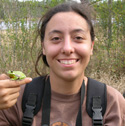Kristine Hoffmann, M.S. (Dec. 2007)
Email: keh5u@uvawise.edu
 Kris received a Master of Science degree in
December 2007 from the
Department of Wildlife Ecology and Conservation at the University of
Florida. Kris conducted research on the invasive Cuban Treefrog
(Osteopilus septentrionalis). This large treefrog, introduced
into Florida in the 1920’s through cargo, has since become firmly
established and is believed to impact the native amphibians and
reptiles through competition and direct predation. Kris’s research
focused on evaluating the impacts of this invasive species on the
native treefrogs in Florida. After graduating from UF, Kris worked as a
biologist in Massachusetts, assisting with a long term radiotelemetry
study of several snake and turtle species. In the fall of 2008, Kris
accepted a position as a Teaching Fellow of Biology at the University
of Virginia College at Wise, where she hopes to inspire a new generation
of students with her passion for biology.
Kris received a Master of Science degree in
December 2007 from the
Department of Wildlife Ecology and Conservation at the University of
Florida. Kris conducted research on the invasive Cuban Treefrog
(Osteopilus septentrionalis). This large treefrog, introduced
into Florida in the 1920’s through cargo, has since become firmly
established and is believed to impact the native amphibians and
reptiles through competition and direct predation. Kris’s research
focused on evaluating the impacts of this invasive species on the
native treefrogs in Florida. After graduating from UF, Kris worked as a
biologist in Massachusetts, assisting with a long term radiotelemetry
study of several snake and turtle species. In the fall of 2008, Kris
accepted a position as a Teaching Fellow of Biology at the University
of Virginia College at Wise, where she hopes to inspire a new generation
of students with her passion for biology.
Publications
Peer-reviewed Publications
- Hoffmann, K.E., S.A. Johnson and M.E. McGarrity. 2009. Interspecific Variation in Use of Polyvinyl Chloride (PVC) Pipe Refuges by Hylid Treefrogs: A Potential Source of Capture Bias. (762KB pdf) Herpetological Review 40:423-426.
- Hoffmann, K., M.E. McGarrity, and S.A. Johnson. 2008. Technology meets tradition: A combined VIE-C technique for individually marking anurans (825KB pdf). Applied Herpetology 5:265-280.
Thesis Abstract (Full-text link below abstract)
TESTING THE INFLUENCE OF CUBAN TREEFROGS (Osteopilus septentrionalis) ON NATIVE TREEFROG DETECTION AND ABUNDANCE
The Cuban treefrog (Osteopilus septentrionalis) is a nonindigenous species in Florida that anecdotally replaces native treefrog species where it becomes established. However, few empirical data are available to verify this claim; thus, I sought to determine the effects of O. septentrionalis on native treefrog populations. I removed O. septentrionalis from natural areas and monitored the response of native treefrog populations using polyvinyl chloride (PVC) pipe refugia. In conjunction with my field study, I conducted laboratory experiments to determine the frequency at which treefrogs use PVC pipe refugia and to test the null hypothesis that O. septentrionalis does not affect behaviorally or chemically exclude native treefrogs from refugia.
In my first laboratory study, I compared the variation by species in frequency of refugia used when treefrogs were presented with the choice of either a PVC pipe refugia or a plant. I found that the native squirrel treefrog (Hyla squirella) rested in the pipe twice as often as on the plant, and Osteopilus septentrionalis used the pipes infrequently. The other two natives tested, green treefrog (H. cinerea) and pinewoods treefrog (H. femoralis), did not strongly favor either the PVC pipe refugia or the plant.
In my other laboratory studies, I tested if Osteopilus septentrionalis interferes with the use of PVC pipe refugia by native treefrogs. First, I paired a native treefrog (Hyla sp.) with an O.septentrionalis in an aquarium with only one pipe, and then observed which frog(s) rested inside the PVC pipe refugium 14 hours later. I found that O. septentrionalis did not behaviorally exclude native treefrogs from refugia. In another study, I presented treefrogs with a choice of a new PVC pipe refugium and one that had been recently used by O. septentrionalis to determine if treefrogs avoided refugia recently used by this predator. I found that Hyla cinerea and H. femoralis did not avoid refugia that were recently used by O. septentrionalis. These laboratory studies suggest that native treefrog detection in PVC pipe refugia is not altered by the presence of similar sized O. septentrionalis.
In my field experiment, I established paired grids of PVC pipe refugia to attract treefrogs at three study sites at Wekiwa Springs State Park, Apopka, Florida, and at three study sites at Flatwoods Park, Hillsborough Wilderness Park, Tampa, Florida. One grid of each pair was used as a treatment grid where I removed Osteopilus septentrionalis, and the other served as a control. I monitored the community of native treefrogs within each grid, and hypothesized that if O. septentrionalis reduces the abundance of native treefrogs, then at sites where this species was removed native treefrogs should become more abundant. However, capture rates were low and few O. septentrionalis were removed to potentially decrease its abundance. Therefore, I was not able to determine if its removal positively impacts native treefrog abundance. However, my data did indicate a negative correlation between the abundance of O. septentrionalis and Hyla femoralis. More research is needed to determine the cause of this relationship.
- Hoffmann, K.E. 2007. Testing the influence of Cuban Treefrogs (Osteopilus septentrionalis) on native treefrog detection and abundance. (401KB pdf). M.S. Thesis, University of Florida.